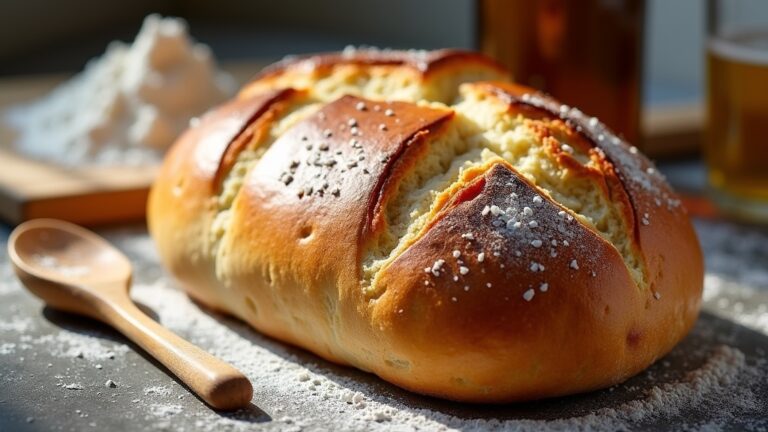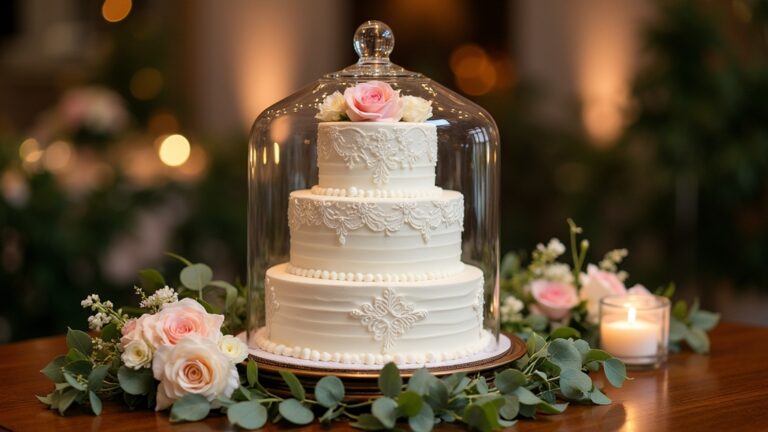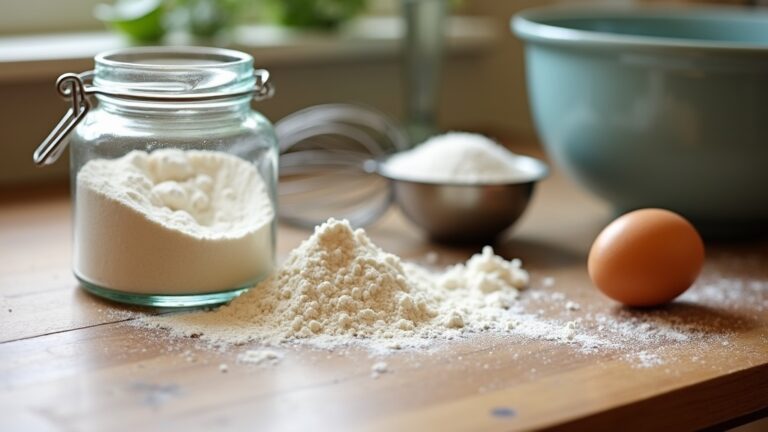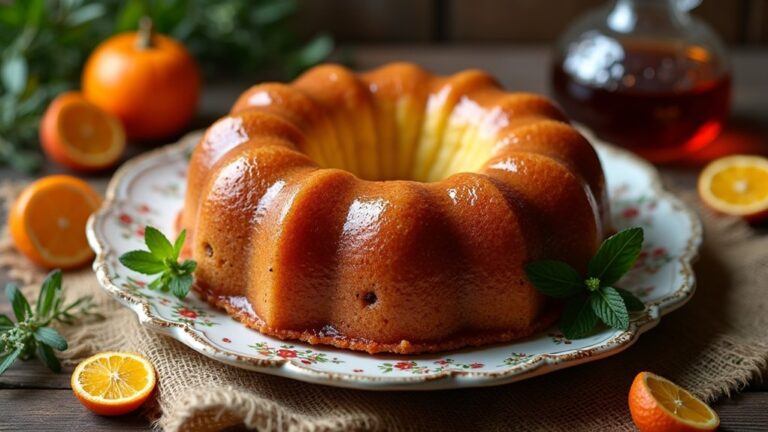Cake Frosting Recipe
I’ve got a simple cake frosting recipe that’ll elevate any cake! Start with unsalted butter and sifted powdered sugar, mixing them together until smooth. Add a splash of vanilla extract and heavy cream for richness, then whip until light and fluffy. Make sure to scrape the bowl sides for an even consistency. This frosting not only tastes divine, but it also allows for creative decoration. Stick around for more tips and techniques to make your frosting truly shine!
Contents
History
When I think about the history of cake frosting, it’s fascinating to realize that it dates back centuries, evolving with culinary practices and societal changes. Initially, frosting was a simple mixture of sugar and egg whites, but as time progressed, we saw the frosting evolution into more complex blends, incorporating butter, cream, and flavorings. Different cultures have contributed unique variations; for instance, the Italian meringue and the rich Swiss buttercream showcase regional influences. These cultural variations highlight how frosting not only enhances cake but also reflects the artistry and innovation of each era. As I explore this delectable history, I can’t help but appreciate the creativity that continues to inspire bakers today, pushing the boundaries of traditional frosting techniques.
Recipe
Creating the perfect cake frosting can elevate any cake from ordinary to extraordinary. A well-made frosting adds a delightful sweetness and texture that complements the cake itself. Whether you’re preparing a classic vanilla buttercream or experimenting with flavors like chocolate or cream cheese, this cake frosting recipe is sure to be a hit for any occasion.
Elevate your cake with perfect frosting that adds sweetness and texture, making every occasion special.
This frosting is versatile and can be used for decorating, filling, or simply spreading over your favorite cake. With just a few basic ingredients, you can whip up a batch in no time. The key to achieving a smooth and creamy consistency lies in the technique used during preparation, so be sure to follow the steps carefully for the best results.
Ingredients:
- 1 cup unsalted butter, softened
- 4 cups powdered sugar
- 1/4 cup heavy cream
- 1 teaspoon vanilla extract
- Pinch of salt
To make the frosting, start by beating the softened butter in a large mixing bowl with an electric mixer until it becomes light and fluffy. Gradually add in the powdered sugar, mixing on low speed until combined. Once the sugar is incorporated, pour in the heavy cream, vanilla extract, and a pinch of salt. Increase the mixer speed to medium-high and beat for 2-3 minutes until the frosting is smooth and creamy. If the frosting is too thick, you can add a little more cream; if it’s too thin, add more powdered sugar until you reach your desired consistency.
When preparing your frosting, remember to use room temperature butter for a smoother blend, and sift your powdered sugar to avoid lumps. You can also customize the flavor by adding different extracts, such as almond or lemon, or by mixing in cocoa powder for a chocolate version. If you’re decorating a cake, consider chilling the frosting for about 10-15 minutes before spreading it, as this will help it hold its shape better. Enjoy experimenting with colors and designs for a truly personalized touch!
Cooking Steps
Let’s get started by gathering all the ingredients you’ll need for the perfect frosting. I always mix in the powdered sugar first, as it sets the foundation for a smooth texture. Once that’s in, we’ll add the vanilla extract to enhance the flavor before incorporating the heavy cream for that delightful fluffiness.
Step 1. Gather Your Ingredients First
Before diving into the delightful process of frosting a cake, I’ve found it essential to gather all my ingredients first. This step not only streamlines the process but also sparks creativity for ingredient variations. I typically start with unsalted butter, heavy cream, and vanilla extract as my base. Depending on the flavor profile I’m aiming for, I might incorporate cocoa powder for a rich chocolate twist or citrus zest for a revitalizing hint. Don’t forget the essential tools: a mixing bowl, a hand mixer, and an offset spatula. Having everything ready at hand guarantees that I can focus on crafting the perfect frosting without interruptions. With my ingredients and tools assembled, I’m ready to create something truly special!
Step 2. Mix in Powdered Sugar
As I begin mixing in the powdered sugar, I take care to sift it first to eliminate any lumps that could mar the smooth texture of my frosting. This simple powdered sugar technique is essential for achieving that velvety finish. I start by adding a cup of sifted sugar to my butter mixture, and I blend on low speed to avoid a sugary cloud. Gradually, I increase the speed, allowing the sugar to integrate seamlessly. I pause occasionally to scrape down the bowl, ensuring every bit gets incorporated. If the frosting seems too thick, I’ll add a splash of milk to adjust the frosting consistency, blending until I achieve that perfect, spreadable texture. It’s all about precision and finesse!
Step 3. Add Vanilla Extract
Adding a splash of vanilla extract transforms my frosting from simply sweet to exquisitely flavorful. This little addition not only enhances the taste, but it also offers numerous vanilla benefits, such as its aromatic properties that elevate the overall sensory experience. I often choose pure vanilla extract for its rich, authentic flavor, rooted in the delicate orchid blossoms of the vanilla bean, which has origins tracing back to Mesoamerica. When I incorporate this extract, I make certain to blend it thoroughly, allowing its complexities to meld seamlessly with the other ingredients. Just a teaspoon can make a world of difference, creating a luscious frosting that complements any cake, while celebrating the exquisite nuances of vanilla’s heritage.
Step 4. Incorporate Heavy Cream
To achieve a creamy, luscious texture in my frosting, I incorporate heavy cream at the right moment. I wait until my butter and sugar are well blended, then add the heavy cream, which enhances the frosting’s richness and provides that silky mouthfeel. The heavy cream benefits are undeniable; it not only adds flavor but also helps achieve a spreadable consistency that’s perfect for decorating. If you’re seeking heavy cream alternatives, options like mascarpone or even coconut cream can work in a pinch, but they may alter the flavor profile slightly. Experimenting with these alternatives can lead to unique results, though I always return to heavy cream for that classic, decadent taste that elevates any cake.
Step 5. Whip Until Light and Fluffy
Whip the mixture until it transforms into a light and fluffy cloud of deliciousness. This is where the magic happens! Using efficient whipping techniques, I focus on achieving an airy consistency that elevates my frosting. Start at a low speed to incorporate air gradually, then increase to medium-high, watching for those texture differences that indicate perfection. The key is to stop once soft peaks form; over-whipping can lead to graininess, ruining that silky finish. I often pause to scrape down the sides, ensuring every bit gets the attention it deserves. With each turn of the whisk, I can feel the transformation—what begins as a dense cream evolves into an ethereal delight that’ll embrace any cake beautifully.
Nutritional Guide
Understanding the nutritional aspects of cake frosting can transform how you approach your baking endeavors. By being mindful of caloric content and exploring ingredient alternatives, you can create a frosting that suits your dietary needs without sacrificing flavor.
Here’s a quick reference table to guide you:
| Ingredient | Caloric Content (per 100g) |
|---|---|
| Butter | 717 |
| Cream Cheese | 342 |
| Coconut Oil | 862 |
Consider substituting traditional ingredients with lighter options like Greek yogurt or avocado. These alternatives not only reduce calories but also enhance the nutritional profile of your frosting. By experimenting with these choices, you can achieve a deliciously innovative result while keeping your health goals in check.
Final Thoughts
While creating the perfect cake frosting can be a delightful challenge, it is essential to remember that the right balance of taste and nutrition can elevate your baking. I’ve experimented with various frosting variations, from classic buttercream to innovative whipped cream blends, each offering unique textures and flavors. Don’t shy away from using natural sweeteners or incorporating fruits for a healthier twist. Cake decorating isn’t just about aesthetics; it’s about enhancing the overall experience. A beautifully frosted cake not only captivates the eye but also invites a delightful taste sensation. So, whether you’re aiming for a simple finish or an elaborate design, let your creativity flow. With practice, you’ll master the art of frosting that’s both delicious and visually stunning.
Frequently Asked Questions
Can I Use Vegan Alternatives in Frosting Recipes?
I often use vegan butter and plant-based milk in my frostings. They create a creamy texture and rich flavor, proving that delicious alternatives can elevate any recipe while keeping it entirely plant-based. It’s innovative and satisfying!
How Can I Thicken My Frosting if It’s Too Runny?
When my frosting’s too runny, I picture a fluffy cloud needing a bit more structure. I sift in cornstarch or powdered sugar, gradually thickening it until it reaches that perfect, creamy consistency I adore.
What Tools Are Best for Frosting a Cake?
When I frost a cake, I rely on an offset spatula for smooth, even layers, and piping bags for intricate designs. These tools help me achieve a professional finish that always impresses my friends and family.
How Long Can I Store Leftover Frosting?
When it comes to leftover storage, I’ve found frosting stays fresh in the fridge for up to two weeks. Its shelf life decreases if left at room temperature, so refrigerate it for ideal flavor and texture.
Can I Freeze Frosted Cakes for Later Use?
They say, “A stitch in time saves nine.” I’ve found that freezing frosted cakes is possible with proper storage. For best results, wrap them tightly and follow freezing tips for ideal frosted storage. Enjoy your treats later!
Conclusion
In summary, making your own cake frosting is not just a culinary task; it’s a delightful journey into a world of sweetness that’ll make your taste buds dance like they’ve won the lottery! With just a few simple ingredients and steps, you can create a frosting that’s not only delicious but also adds that perfect touch to your baked creations. So, grab your mixing bowl, release your creativity, and let every bite of your cake be pure bliss!






